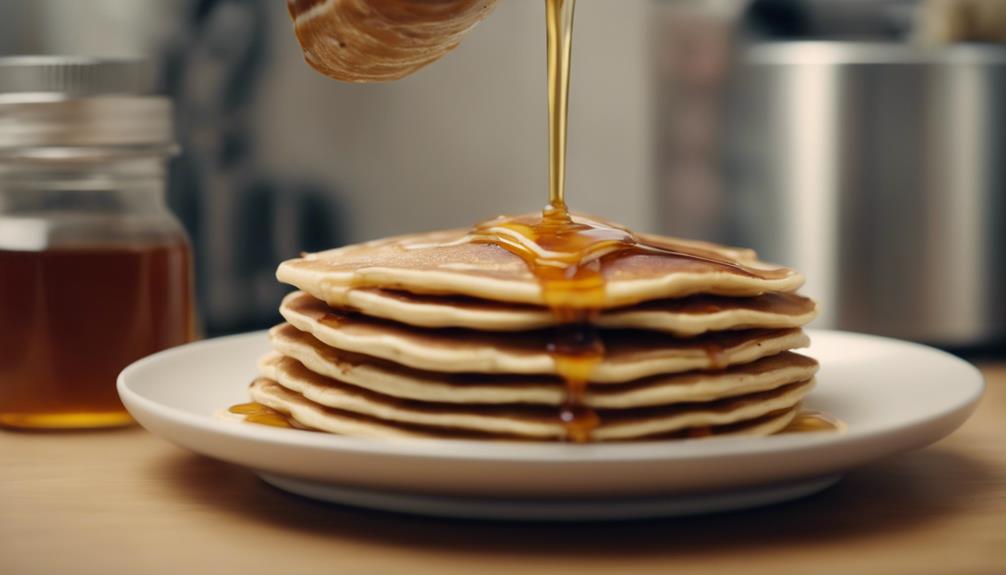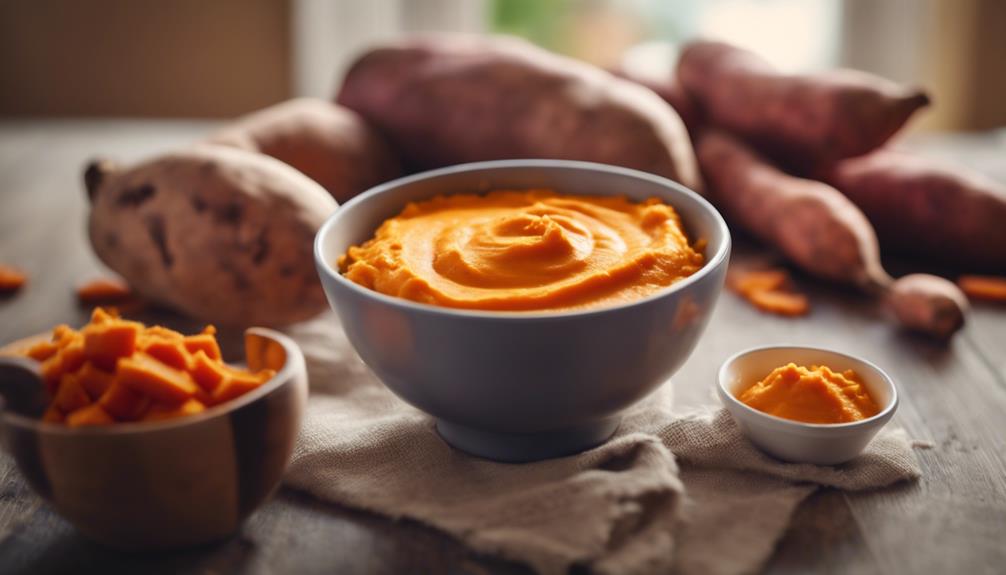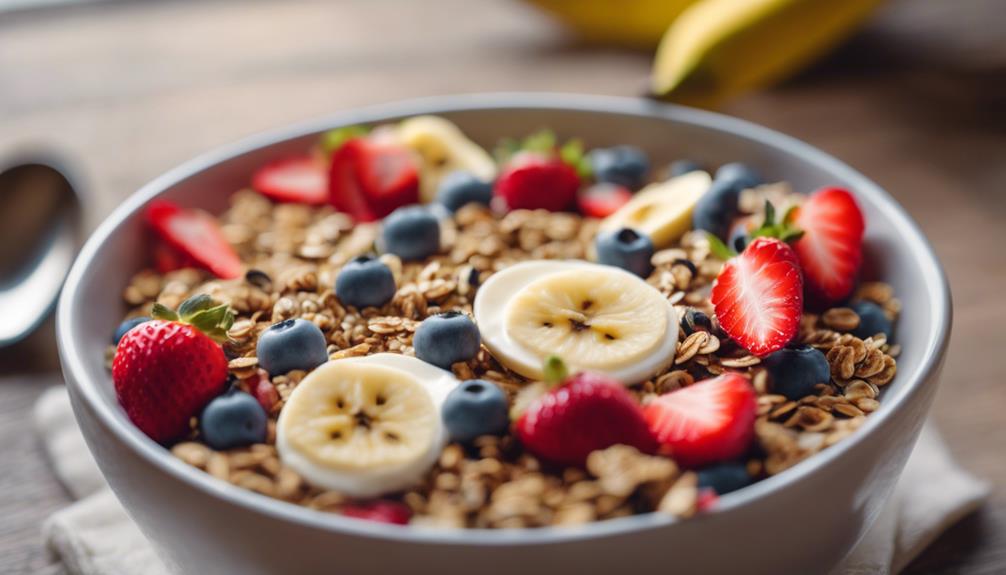Indulge your little one in the deliciousness of **apple pancakes** for a delightful morning treat. For **fluffy pancakes**, make sure to use a non-stick pan and a smooth batter, then cook them on medium-low heat until well done. Cut into bite-sized pieces for the little eaters, and top with **nut butter** or fruits for a burst of flavor. Leftovers can be stored in the fridge and gently reheated when hunger strikes. Experiment with different spices or flours, such as **oat flour**, for gluten-free options. By following these simple tricks, your baby will savor each mouthful of these scrumptious apple pancakes! Discover more secrets to elevate your baby’s breakfast routine and make mealtime more exciting. Start the day off right with this irresistible breakfast choice!
Key Takeaways
- Cut pancakes into baby-friendly sizes for easy handling.
- Introduce nut butter for added protein and healthy fats.
- Serve with mashed or cut fruits for a balanced meal.
- Experiment with cinnamon or nutmeg for flavor variety.
- Opt for thin pancakes to ensure even baking.
Pancake Preparation Tips
For even baking and easy flipping of your apple pancakes, opt for a non-sticky pancake pan. This choice will guarantee that your pancakes come out perfectly cooked without any sticking issues.
When preparing your pancake batter, remember to keep it smooth and free of lumps for a delightful texture. Once your batter is ready, heat up your pan on a medium-low setting to avoid burning the pancakes.
A non-stick pan will aid in cooking your apple pancakes evenly and prevent any unwanted greasiness. Consider using a small amount of olive oil for a healthier cooking option that adds a delicious flavor to your pancakes.
Additionally, aim for thin pancakes to promote even baking without overbrowning. By following these tips, you can create delectable apple pancakes that are sure to be a hit with your little one.
Serving Suggestions for Babies

Consider cutting the apple pancakes into finger-length pieces to encourage self-feeding in 6-9 month-olds. As your baby grows and develops their pincer grasp, serving bite-size pieces for 9 months and older can help improve their dexterity.
Enhance the nutritional value of the pancakes by adding a thin layer of nut butter, providing essential protein and healthy fats for your little one. For a fun and nutritious meal option, create nut butter sandwiches using pancake pieces for toddlers, offering a delightful twist on a classic favorite.
Additionally, pair the pancakes with mashed or cut fruit suitable for your baby's age as a complementary side, adding a burst of freshness and natural sweetness to the meal.
- Cut pancakes into finger-length pieces for young babies.
- Serve bite-size pieces for older babies to encourage self-feeding.
- Include a thin layer of nut butter for added protein and healthy fats.
Storage and Reheating Guidelines

When it comes to storing those delicious apple pancakes for your baby, remember to keep them in the fridge within an airtight container for up to 3 days.
Freezing leftovers is also an option; just make sure to place parchment paper between each pancake for easy defrosting and storage for up to 3 months.
And when it's time to reheat, whether in the oven, toaster, or microwave, make sure they're thoroughly warmed through for the best taste and quality!
Storage Guidelines
To maintain the freshness and quality of your apple pancakes, make sure to store them in an airtight container in the fridge for up to 3 days.
When it comes to storing these delicious treats, here are some handy tips to keep in mind:
- Store: Place your apple pancakes in an airtight container to preserve their flavor and texture.
- Airtight Container: Using an airtight container helps prevent moisture loss and keeps your pancakes moist.
- Freeze: If you want to extend the shelf life, you can freeze your apple pancakes with parchment paper between each pancake for easy defrosting and separation.
Reheating Instructions
To reheat your apple pancakes stored in the fridge or freezer, make sure to follow these simple instructions to enjoy a warm and delicious breakfast anytime.
When you're ready to reheat, consider using the oven for a crispy texture that will make your taste buds dance. Preheat your oven to 350°F, place the pancakes on a baking sheet, and warm them for about 10-15 minutes. If you're in a rush, the toaster or microwave can also do the trick from frozen – just keep an eye on them to avoid overheating.
For peak freshness, store any leftover apple pancakes in an airtight container in the fridge for up to 3 days. If you choose to freeze them, separate each pancake with parchment paper for hassle-free defrosting.
Variations and Recipe Ideas

Consider enhancing the flavor of apple pancakes for your baby by experimenting with different variations and recipe ideas. Here are some creative ways to elevate your baby's breakfast treat:
- Sprinkle a dash of cinnamon or nutmeg into the pancake batter for a warm and aromatic twist.
- Swap out regular flour with oat flour for a gluten-free option that adds a nutty flavor to the pancakes.
- Mix mashed bananas or sweet potatoes into the batter for a naturally sweet and nutritious addition.
These simple changes can take your apple pancakes to a whole new level, providing variety in taste and texture while ensuring your baby enjoys a delicious and wholesome meal.
Whether you choose to play with spices, alternative flours, or additional fruits and veggies, the possibilities are endless when it comes to customizing this classic breakfast dish for your little one.
Nutritional Information and More Recipes

Ready to explore more about the nutritional content and uncover new recipes for your little one's pancake adventures?
Delve into the details of the nutritional information, get inspired by additional recipe ideas, and explore healthy variations that will keep your baby or toddler excited for breakfast time.
You'll find a wealth of tasty options that not only nourish but also delight tiny taste buds, making mealtime a fun and nutritious experience for the whole family!
Nutritional Information Overview
Explore the nutritional breakdown and discover additional pancake recipes to broaden your baby's breakfast options. When making apple pancakes for your little one, you can rest assured that each serving packs about 27 calories, 5g of carbohydrates, 1g of protein, and 1g of fat, offering a wholesome start to the day.
To cater to different dietary needs, consider swapping whole milk for a plant-based alternative like almond or oat milk for a dairy-free twist. Experimenting with gluten-free flour options can introduce new textures and flavors to these delightful treats. Remember, selecting sweeter apple varieties can enhance the natural sweetness of the pancakes without requiring additional sugars.
Try Healthy Fluffy Oat Flour Pancakes for a nutritious twist.
Sweet Potato Pancakes offer a unique and tasty alternative.
Give Fluffy Gluten-free Buckwheat Banana Pancakes a go for a gluten-free delight.
Additional Recipe Ideas
To learn more about the nutritional content and diverse pancake recipes, including healthy options like Oat Flour Pancakes and Sweet Potato Pancakes, continue exploring below.
When preparing pancake batter, consider adjusting the consistency by adding a bit more liquid to make it thinner if you prefer lighter, fluffier pancakes. Don't let any leftover pancakes go to waste; store them in the fridge for a quick snack or breakfast on the go.
If you're looking to incorporate more whole grains into your diet, experiment with using wheat or rye flour in your pancake recipes. These options not only add a nutty flavor but also boost the fiber content of your pancakes. For a naturally sweet twist, opt for sweeter apple varieties in your pancake mix to enhance the flavor without the need for additional sugars.
Get creative with your pancake toppings and spreads to cater to your taste preferences. Customize your pancakes with a variety of fruits, nuts, seeds, or even a dollop of yogurt for a delightful and nutritious breakfast experience.
Healthy Pancake Variations
For a nutritious twist to your pancake repertoire, consider trying out different healthy pancake variations that offer diverse flavors and nutritional benefits.
- Fluffy Oat Flour Pancakes: Incorporate oat flour for a hearty texture and a boost of fiber in your pancakes.
- Sweet Potato Pancakes: Add mashed sweet potatoes to your batter for a delicious dose of vitamins and minerals.
- Experiment with Whole Wheat: Swap traditional all-purpose flour with whole wheat flour to increase the fiber content and add a nutty flavor to your pancakes.
When making these healthy pancake variations, remember to utilize baking powder to guarantee your pancakes rise and have a fluffy consistency.
Whole wheat flour provides more nutrients compared to all-purpose flour, making your breakfast choice a healthier option.
These variations not only offer a different taste but also bring various nutritional benefits to the table.
Recipe Basics

You'll find that mastering the recipe basics for apple pancakes is straightforward and rewarding. To start, gather your ingredients for these delightful treats. You'll need whole wheat flour for a healthier option, along with oats for added texture. Don't forget cinnamon to bring warmth to the flavor profile. In addition, make sure you have milk to create a smooth batter, butter for richness, and eggs to bind everything together. A splash of vanilla extract will enhance the overall taste, while fresh apples will provide a fruity sweetness that babies will love.
When it comes to baking these pancakes, the key is to achieve a fluffy and hearty texture that's perfect for those tiny tummies. By following the recipe closely and paying attention to details like mixing the batter just right and cooking over medium heat, you'll be on your way to creating a delicious breakfast option for your little one.
Stay tuned for the next step in preparing these delightful apple pancakes!
Cooking Instructions

Begin by grating the apple and combining it with the whole wheat flour, oats, cinnamon, baking powder, milk, eggs, butter, and vanilla extract in a bowl.
Once you have your batter ready, it's time to cook up some delicious apple pancakes! Here's what you need to do:
- Heat a pan over medium heat and grease it lightly.
- Pour the batter onto the pan to form your pancakes.
- Cook until bubbles start to form on the surface, then flip and cook until they're fluffy and cooked through.
Once your apple pancakes are golden brown and ready to eat, transfer them to a plate.
If you have any leftovers, make sure to store them in an airtight container to keep them fresh. Whether you enjoy them right away or save some for later, these sweet breakfast treats are sure to be a hit with your little one!
Tips for Success

To guarantee successful apple pancakes, finely grate the apple to evenly distribute its flavor throughout the pancake batter. Using a non-stick pan and cooking on low to medium heat will result in perfectly cooked pancakes that are not burnt on the outside and raw on the inside. Add a pinch of cinnamon to the batter for a warm and cozy flavor that complements the apple beautifully. Opting for whole wheat flour adds fiber and essential nutrients to the pancakes, making them a healthier choice for your little one.
Here are some additional tips to make sure your apple pancakes turn out just right:
| Tips for Success |
|---|
| Cool the Grated Apple |
| Mix the Pancake Batter in a Medium Bowl |
| Use Whole Wheat Flour |
| Cook on Low to Medium Heat |
Cooling the grated apple before adding it to the batter helps prevent the pancakes from becoming too soggy. Mixing the pancake batter in a medium bowl ensures even distribution of ingredients. Remember to cook the pancakes on low to medium heat for that perfect golden brown color and fluffy texture.
Frequently Asked Questions
Can Babies Eat Pancakes and Syrup?
You shouldn't give babies pancakes with syrup due to the risk of botulism. Stick to nutritious ingredients like whole wheat flour, oats, milk, and eggs. Opt for toppings like mashed fruit or yogurt instead for a safe and tasty meal.
How to Serve Pancakes to a 6 Month Old?
To serve pancakes to a 6-month-old, cut them into small pieces for easy handling. Avoid honey and syrup. Serve plain pancakes without spreads. Make certain they're soft and easy to mash. Watch closely to prevent choking.
Can Pancakes Be Eaten as Dessert?
Pancakes can definitely be enjoyed as dessert! Add toppings like maple syrup, honey, or fruit compote for sweetness. Experiment with fillings like chocolate chips or caramelized apples. Customize with different flavors for a gourmet treat.
How to Prepare Apples for a 9 Month Old?
To prepare apples for a 9-month-old, peel, core, and finely grate them for safety. Cook until soft, mashable, and unsweetened. Mix into pancake batter for added sweetness. Make sure apple pieces are small and soft for easy chewing.
Conclusion
To sum up, these apple pancakes for baby are a total game-changer!
Your little one will devour them faster than you can say 'pancake perfection.'
So go ahead, whip up a batch and watch as your baby's face lights up with joy.
Breakfast will never be the same again!










